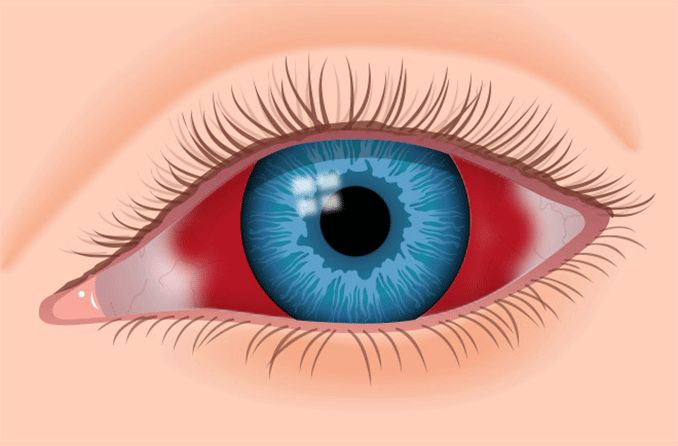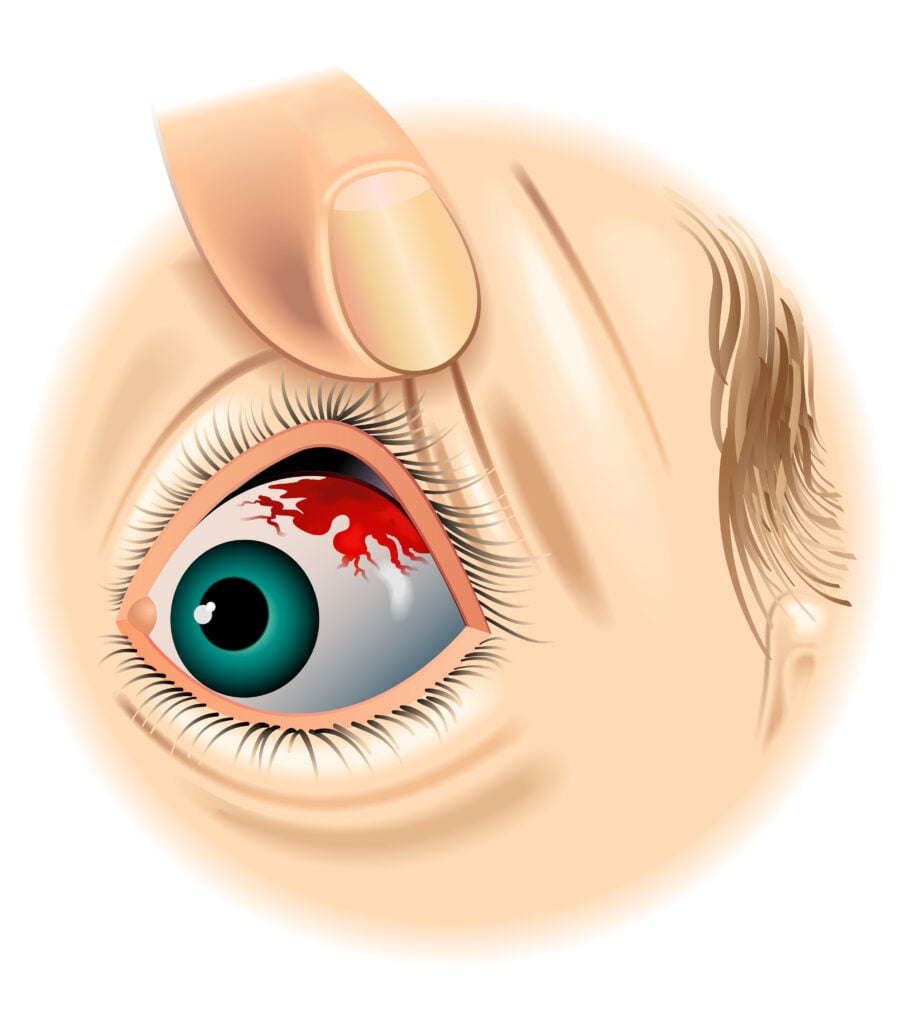If you feel something in your eye, remove the contact lens and clean it thoroughly. Do not wear contact lenses longer than your eye doctor suggests. Always replace them when necessary.
Subconjunctival Hemorrhage (Blood in Eye) – Causes & Treatment

A subconjunctival hemorrhage is a bright red spot on the white of your eye (sclera). It’s caused by a popped blood vessel under the thin, clear tissue (conjunctiva) that covers the sclera. A subconjunctival hemorrhage can cause a small red spot on your eye or it can cover the entire sclera, causing a dramatic red, bloody eye.
Though it may look scary, a subconjunctival hemorrhage is harmless and typically goes away without treatment within a week or two.
A subconjunctival hemorrhage is blood on the front of the eye. Don’t confuse it with blood in the front of the eye. Blood in the eye (behind the clear cornea) is a serious condition called a hyphema. Unlike a subconjunctival hemorrhage, a hyphema requires immediate attention from an eye doctor.
Subconjunctival hemorrhage symptoms
Subconjunctival hemorrhages usually don’t have any symptoms.
(The medical terms symptom and sign are often confused or misused. Symptoms are indicators of a condition that can be recognized only by the persing experiencing them. Blurry vision is an example of a symptom. Signs are indicators that can be seen by others as well as the person experiencing them. A red eye is an example of a sign.)
A subconjunctival hemorrhage looks like a bright red spot on the white part of the eye. In some cases, it will cover the entire white area.
A subconjunctival hemorrhage doesn’t cause symptoms like blurry vision or eye pain. The only symptom a bloody eye from a popped blood vessel might cause is a mild scratchy feeling on the surface of your eye.
But the primary sign of a subconjunctival hemorrhage — a bright red spot on the white of your eye — is unmistakeable. It can be a relatively small spot or cover a large area of your sclera. Also, it might start as a small spot and get larger as the day goes on.
Sometimes, the bloody spot from a subconjunctival hemorrhage can expand to cover the entire white of your eye.
In most cases, a subconjunctival hemorrage will disappear on its own within a week or two. During this time, the spot will become less red and more yellow in color as the blood is resorbed (removed) by the body. If a subconjunctival doesn’t go away completely or get significantly smaller within two weeks, see an eye doctor.
What causes a subconjunctival hemorrhage?
Something as simple as a cough or a sneeze can cause a subconjunctival hemorrhage and bloody eye.
Other potential causes include:
- Eye trauma
- A sudden increase in blood pressure (e.g., from lifting something heavy)
- Straining due to constipation
- Vomiting
- Rubbing your eyes
- Eye surgery, including LASIK and cataract surgery
- Drug side effects
Risk factors for subconjunctival hemorrages include:
- Diabetes
- High blood pressure
- Having a “cold” or allergies (that increase coughing and sneezing)
- Wearing contact lenses (increases eye rubbing)
- Use of aspirin or blood thinners
- Aging (over age 50)
- Blood clotting disorders
- Vitamin K deficiency
But often, the cause of a subconjunctival hemorrhage is unknown.
How are subconjunctival hemorrhages treated?
There really is no treatment for subconjunctival hemorrhages. In some cases, eye drops (artificial tears) are recommended to keep the surface of the eye well-lubricated while the natural healing process takes place.
If you are taking aspirin, blood thinners, or other medications, continue taking them unless your doctor instructs you to do otherwise.
How to prevent subconjunctival hemorrhages
Follow these tips to avoid a bloody eye from a popped blood vessel under the conjunctiva:
- Wear safety glasses and protective sports eyewear to avoid eye injuries.
- Avoid rubbing your eyes. If your eyes itch, see an eye doctor to determine the cause and possible treatments.
- Wear contact lenses responsibly. Clean and disinfect your contacts as directed, and don’t overwear your lenses.
- Stay healthy. Get plenty of exercise and rest and eat a healthful diet to avoid getting sick.
- Control your allergies. See your physician or eye doctor to help prevent eye allergies and allergy-related coughing and sneezing.
- Keep any blood disorders or health problems (e.g., diabetes; hypertension) under control with routine health care visits.
Remember: Subconjunctival hemorrhages are harmless and usually go away within a week or two. But if you have a persistent bloody eye or frequent popped blood vessels on your eye, see an eye doctor.
Red Spot on Eye

Vision Center is funded by our readers. We may earn commissions if you purchase something via one of our links.
In this article
Overview: Red Spot on Eye
The whites of your eyes can easily show any red spots that develop. While a red spot on your eyeball is often harmless, it is best to have your doctor rule out anything serious, even if you think you know the cause.
Often, a red spot results from a subconjunctival hemorrhage, which is a broken blood vessel.
7 Potential Causes of Red Spot on Your Eye
A red spot on the eye is typically harmless. However, there are some conditions your eye doctor will consider if you develop a red mark on your eye:
1. Eye Injury
An eye injury can cause bleeding, resulting in a red spot on the eye. For example, you may get poked in the eye, or something may fly into it.
Even mild trauma, like rubbing your eyes slightly too hard, can lead to broken capillaries and red spots. To avoid eye injury, consider wearing protective eye wear at work or while playing sports if you are exposed to flying objects or debris.
2. Subconjunctival Hemorrhage (Broken Blood Vessel)
In most cases, a red spot on your eye is a small blood vessel that bursts open. This is a subconjunctival hemorrhage.

When one of the tiny blood vessels breaks open, the blood moves underneath the conjunctiva. In some circumstances, the blood can spread across the whole white of the eye. While this can be nerve-wracking, most people do not feel any pain, irritation, or light sensitivity.
Subconjunctival hemorrhages are similar to a bruise on your skin. However, the bright red color is significantly more visible because it is under the clear and transparent conjunctiva in front of your sclera.
There are many causes of subconjunctival hemorrhages. These include trauma, constipation, straining too much, lifting something hefty, diabetes, and hypertension.
3. Diabetic Retinopathy
Diabetic retinopathy is not a typical cause of red spots in the eye. However, it is the most common cause of vision loss among people with various types of diabetes.

The condition results in retinal blood vessels leaking fluids or bleeding. Symptoms of diabetic retinopathy include floaters and blurry vision.
Eye floaters are spots, lines, or rings that move through your field of vision. Because the retina is located in the back of the eye, you cannot see these red spots yourself.
The only way to determine if you have diabetic retinopathy is to see your eye doctor. If you have diabetes, schedule a comprehensive dilated eye exam annually or as advised by your doctor.
4. Blood Pressure Spike
Anything that makes you strain can quickly and temporarily spike your blood pressure. Straining can potentially break a few capillaries in your eyes, leading to red spots.
Some examples of straining activities include:
- Coughing
- Sneezing
- Vomiting
- Bowel movements
- Childbirth
- Heavy lifting
5. Contact Lens-Related Irritation
Even just a speck of dust trapped behind your contact lenses can irritate the eye. If you respond by rubbing your eye, this can worsen the irritation and cause redness or broken blood vessels.
If you feel something in your eye, remove the contact lens and clean it thoroughly. Do not wear contact lenses longer than your eye doctor suggests. Always replace them when necessary.
Wear sunglasses to protect your eyes against wind, dirt, and outdoor debris. Use suitable eye protection for sports and other activities that could cause something to fly into your eye.
6. Blood Disorders
Sickle cell disease is an inherited bleeding disorder. It is characterized by chronic anemia and intermittent pain. Sickle cell disease is caused by abnormally shaped blood cells with problems transferring hemoglobin and oxygen throughout the body.
People with sickle cell disease sometimes have dilated or abnormal blood vessels in the conjunctiva. This is because of the sickling of red blood cells within small vessels. It can lead to tiny blockages.
It is rare, but developing blood clotting disorders such as hemophilia or von Willebrand disease can also increase the risk of red spots on the eyes.
7. Certain Medications
Some medications thin the blood, making it easier to bleed. This can occur if you frequently take aspirin or if you take interferons.
Other blood thinners include:
- Apixaban (Eliquis)
- Dabigatran (Pradaxa)
- Enoxaparin (Lovenox)
- Heparin
- Rivaroxaban (Xarelto)
- Warfarin (Coumadin, Jantoven)
How Are Red Eye Spots Diagnosed?
Your doctor can diagnose a red spot on the eye by looking at it. If you have symptoms that suggest something more serious, you will likely require a comprehensive eye exam. Your eye doctor may use tools like a slit lamp or an ophthalmoscope.
The doctor may also ask questions about your symptoms. Questions may include how long the spot has been present and if it’s causing any pain or discomfort.
Some doctors may sample the fluid from the red spot and send it to a lab for testing. This can help determine if an infection causes the red spot.
How to Treat Red Spot on Eye
Here are ways to treat a red spot on the eye:
Home Remedies
Artificial tears, otherwise known as eye drops, or cold compresses, can keep the eye comfortable. This is in case any tissue elevates because of a larger hemorrhage.
Professional Treatment
A red spot on your eye will typically clear up within a few days or weeks. Generally, treatment consists of a medical evaluation and reassurance that the red dot will disappear. If the bleeding is significant, it may take slightly longer than a week and turn a yellowish, bruise-type shade before fading.
If you have diabetic retinopathy, vision loss resulting from the medical condition can be irreversible. However, treatment can lower the risk of blindness by 95 percent.
Treatment for diabetic retinopathy includes:
- Injected or implanted corticosteroids
- Anti-vascular endothelial growth factor (VEGF) injections to prevent the protein that triggers the growth of abnormal, leaky blood vessels
- Laser treatment to lessen swelling and fluid leakage
- Eye surgery to repair a detached retina, remove scar tissue, or remove the vitreous (vitrectomy)
- Diabetes management
Summary
Various factors can cause red spots on the eye. Learning about the different causes and treatments can help you better understand how to manage the condition. Home remedies can keep the eye comfortable, while professional treatment may be necessary for more serious cases.






